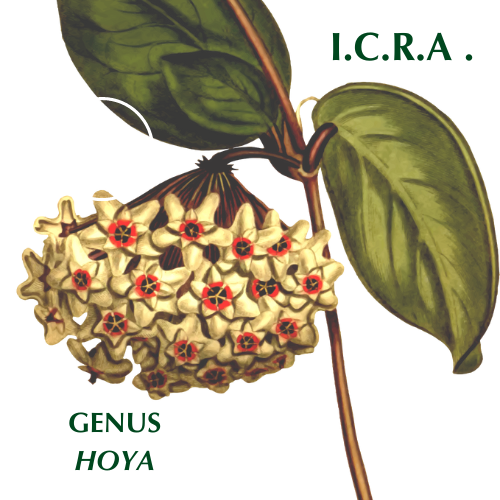Full Name: Hoya carnosa ‘Argentea Picta’ is the Established and Accepted name for a very famous cultivar
First established: in USPP 3,307 by Barnell Cobia (primary owner and founder of B.L.Cobia, Inc., with brother Larry)
Patent: B.L.Cobia,Inc. (1973). MILKWEED PLANT (U.S. Plant Patent No. 3,307). United States Patent Office.
Making ‘Argentea Picta’ a legal variety not equivalent to the taxonomic rank variety (var.), but equivalent to the rank of cultivar.
Synonyms: Undetermined
Not synonomous to Hoya carnosa ‘Picta Argentea’, established with description in Annales de la Societe Royal D’Agriculture et de Botanique de Gand 4 (1848) 218.
Trademarks & Trade Designations: SILVER PRINCESS Date of first use 1968; Registered 1971. Dead/expired 2002. Status ‘Not Found’ in United States Patent and Trademark Office. If secondary sources are found to be reliable, serial and registration number will be updated here.
Later Notable Publications:
Andrews,L. (1977, June). 50 Interesting Hoyas. Plants Alive! p.72.
Graf, A.B. (1992) Tropica pgs.150, 152, & 879. , Graf, A.B.(1976) Exotica pgs.283 & 1631
(1977, June). How new Hoya hybrids come to be. Plants Alive! p.71.
Group & Classification: Cobia, Hoya carnosa Chimera Old
Highlights from the description:
- Appeared as a sport on an “unnamed variety”* which was itself developed from Hoya carnosa ‘Verna Jeanette’
- variegated leaf blades
- loose growth habit (compared to “Hoya carnosa variegata varieties”.. Cobia refers to this as a Group as opposed to a single cultivar, likely due to his own cultivation and work with it in a line)
- “…wavy, splotched and/or streaked variegated leaf blade with certain color characteristics involving red and/or yellow-red hues…” (Cobia, USPP 3,307).
- Flowers frequently do not form fully, instead displaying with a mixture of “Four’s” among the “Five’s” and are described as “frequently deformed.
- Alike to Hoya carnosa ‘Verna Jeanette’ by the same originator. Both have leaf blades with waxy deposits on the leaf blades which are desirable and described as silver.
- Differentiated from ‘Verna Jeanette’ by stems and leaf blades dominated by red-purple, red, and/or yellow-red hues. Please see full description for all color details by part.
- In summary, ‘Argentea Picta’ was developed and released despite visual similarities to ‘Verna Jeanette’ due to significant differences in color.
From Secondary Publication: From the historic 1977 Plants Alive! interview with Cobia’s then-Director of research, Stephen H.Griffith, Hoya carnosa ‘Argentea Picta’ came about as a result of mutation selection from Hoya carnosa ‘Variegata’. From one of the mutations, Hoya carnosa ‘Verna Jeanette’ was selected and produced (meaning it was released to the market and promoted in their product line). It is not clear how many different ‘selections’ were released between the “unnamed” mutation and ‘Argentea Picta’, but Griffith says this: “First, Hoya carnosa ‘Verna Jeanette’ was produced for a few years, then dropped as better varieties were developed. From Verna Jeanette, an improved variety was selected and after a number of years of improvement H.argentea picta was obtained. A patent was issued in 1973.”**
Notes & other sources:
*(On Cobia’s use of the word variety, varieties). These are not established cultivars, botanical varieties below the rank of subspecies, or legal varieties equivalent to the cultivar. He uses this wording frequently in his patents to mean variation within the named cultivar, which he himself has prompted by not labeling them differently when he began selecting and the variation occurred.
**Quoted from article with the names left as they were, and not corrected to be written as cultivars should be.
This is a very slow grower. It had all but disappeared from the marketplace from the late 80’s through the early 2020’s when it made a resurgence with the great upswing in new collectors to the hobby. Demand for both old and novel cultigens was high and widespread.
It appears that most on our market come from collectors in Russia and Florida who had kept them alive all of this time, and they may not all be identical (see ‘Verna Jeanette’ and other earlier similar mutations leading up to Cobia’s 1973 patent).
Because the name ‘Argentea Picta’ was maintained in a patent and legal registry, it is Adopted and the name to use even though it is:
- fully Latin post 1959
- nearly identical to another earlier established name with a strikingly similar description. The earlier established name is not a determined plant and this one is well known.

